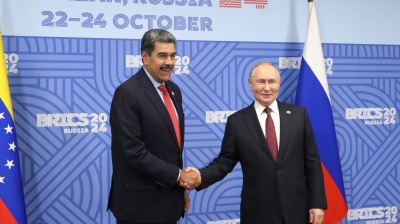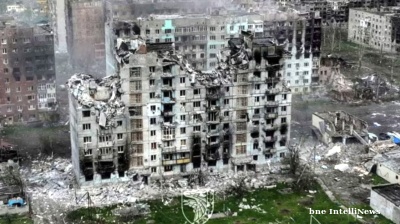Ukraine’s elite HUR forces turn the tide in the battle for Pokrovsk, as Russia’s effort to capture key logistics hub fails

The battle for Pokrovsk became intense on November 1. In the first part of the day it looked like the fall of the key logistics hub to Russia that could end the war was imminent. But a bold special operation by Ukraine’s elite forces seems to have turned the tide at the last moment, according to military blogger reports coming out of the city.
It's hard to be sure of what is happening and there is little formal reporting on this key battle, but milbloggers in touch with individual soldiers are posting updates on social media. In addition, think tanks like the Institute for the Study of War (ISW) have access to satellite imagery that is also a source of information.
As bne IntelliNews reported, at the start of last week, Russia's chief of the general staff Valery Gerasimov has triumphantly reported to President Vladimir Putin that the city was surrounded by the Armed Forces of Russia (AFR). By the end of the week, the situation had become critical as Russian forces broke into the city and fierce street battles broke out.
However, the situation deteriorated further by the start of November 1 as Russian forces captured increasing sections of the city as well as pushing Armed Forces of Ukraine (AFU) troops out of their defensive pockets and the supply lines to the city were almost completely cut, threatening to trap hundreds of defenders in pockets, surrounded by Russian forces.
In desperation, Ukraine mounted a daring counter operation, flying in elite troops by US-made Black Hawk helicopters and dropping them behind enemy lines who appear to have struck a devastating blow that has reversed the tide, according to unconfirmed reports from the city. The offensive was reported by Kyrylo Budanov, Ukraine’s spy master and chief of the Main Directorate of Intelligence of the Ministry of Defence of Ukraine himself, the architect behind much of Ukraine’s defensive strategy, and was spotted on the ground in Pokrovsk leading the defence.
As the day ends, Pokrovsk remains in Ukrainian hands, but with a reported 11,000 AFR troops massed for the assault, intense fighting is expected to resume tomorrow.

Pokrovsk and Myrnohrad encirclement
The AFU remains on its backfoot. Despite having repelled the onslaught, the cities of Pokrovsk and the neighbouring city of Myrnohrad, which is supplied from Pokrovsk, are almost encircled by the “steady but slow” AFR advances, reports Institute for the Study of War (ISW), at the culmination of weeks of preparatory strikes and infiltration missions. Russian forces have been taking advantage of the kilometre-long holes that have appeared in Ukraine’s lines, due to the increasingly acute manpower shortage and more than 200 AFR soldiers broke into the city this week. AFR forces were clearing Ukrainian defensive pockets and asserting growing control over the course of the last week, with Russian drones targeting Ukrainian reconnaissance and supply operations with increasing effectiveness.
Nevertheless, Ukrainian forces had managed limited tactical gains during the week. “Ukrainian forces marginally advanced during recent counterattacks north of Pokrovsk… Geolocated footage published on October 31 indicates that Ukrainian forces recently marginally advanced in eastern Rodynske. Additional geolocated footage… shows Ukrainian forces striking Russian positions in northern Pokrovsk and eastern Rih… ISW assesses that these infiltration missions did not change the control of terrain or the forward edge of the battle area (FEBA),” according to the ISW analysts.
While Russian troops had infiltrated Pokrovsk in small groups, the city remained a “contested grey zone” for most of last week.
By the morning of November 1 the defence of the city looked to be close to collapsing. Russian milblogger @Zlatti71 claimed that Pokrovsk’s defenders were “hours away from encirclement”
“Only a few kilometres remain before Russian forces close the ring… a thousand-strong contingent of the Armed Forces of Ukraine — including the 25th Airborne, 79th Air Assault, and 82nd Air Assault Brigades — will be completely trapped,” @Zlatti71 said in a social media post.
He reported that HUR special forces had been dispatched to break the encirclement, but Russian drones were already tracking their movements. Russian units were also said to be consolidating control of Pokrovsk’s northern outskirts, enabling forward movement of assault troops and had cut supply lines into the city. AFU reports said that troops were still receiving supplies that were being delivered by drones.
However, by around mid-day reports of a Ukrainian special operations forces coordinated counter-attack appeared from within Pokrovsk itself. Acting on Budanov’s direct orders, these HUR units conducted counter-sabotage sweeps across key areas of the city, targeting Russian defence positions and recapturing parts of the city taken by the AFR.

“Ukrainian media report HUR chief Budanov was spotted in Pokrovsk personally overseeing the operation,” military bloggers said, releasing an image of Budanov in fatigues at a field command post.
Within hours, several Russian operatives were captured—including members of Russia's own military intelligence service (GRU), milbloggers reported. Drone footage showed Ukrainian operators ambushing isolated Russian soldiers who had been misled by their own command to believe the city was already completely under Russian control.
Reports of the HUR special operations first appeared the previous evening when The Economist correspondent Oliver Carroll posted video of a Ukrainian operated Black Hawk helicopter landing in a field purportedly near Pokrovsk.

“New. Hearing Ukraine’s military intelligence is conducting a daring counter-offensive near Pokrovsk to reopen key logistics lines. Videos shared with me purport to show a heli drop in areas Russia claims to hold. Have not been able to verify videos independently,” Carroll posted.
It is not clear how big the HUR operation was. In addition to Carroll’s video another video surfaced showing two more Black Hawks flying into the Pokrovsk area, but given the effectiveness of the counter punch it seems likely that more HUR forces were deployed.
Still, the cost was high. One Black Hawk insertion attempt on the northwestern outskirts of Pokrovsk ended in disaster.
As milblogger @OSINTWarfare reported: “Most of the deployed troops were killed or wounded, and the American-made UH-60 Black Hawk helicopter that transported them was destroyed.”
@AMK_Mapping later detailed how the 11 Ukrainian soldiers seen deploying from the drop into the surrounding countryside were hunted down by Russian FPV drones shortly afterwards. Russia confirmed the kill, releasing video from some of the drones as they targeted the fleeing soldiers as well as footage of the helicopter being destroyed by a Russian missile.
Crucial battle
The battle for Pokrovsk is even more important than those for Bakhmut Avdiivka, which both eventually fell to Russia after many months of fighting in May 2023 and February 2024 respectively and allowed Russia to advance deeper into the Donbas. Pokrovsk lies at the nexus of several important road and rail lines that supply most of the AFU’s defence of the Donbas.
If it falls to Russia there is a chance that the whole AFU defence of the Donbas region could collapse shortly afterwards. There are also no more major defensible cities beyond Pokrovsk that would allow Russian troops to advance almost unimpeded all the way to the Dnipro River that divides Ukraine in two and allow them to occupy almost all of the eastern half of the country.
The significance of Pokrovsk is not lost on Ukrainian soldiers. A serviceman with the callsign “Kyianyn” told @SitrepLinks: “There are virtually no fortifications behind these towns. A flat road leads directly to the city of Pavlohrad.”
The political consequences would be significant too. Completing the capture of Donbas is one of Russian President Vladimir Putin’s stated war goals and the collapse of the proposed meeting between between Putin and US President Donald Trump in Budapest this month was due to the Russian president’s refusal to compromise on his demand that the AFU completely quit the Donetsk region, which Russia doesn’t entirely control, according to a report by the Financial Times.
Shortly after the announcement that the meeting has been “postponed” Trump introduced his new oil sanctions, hitting Russia’s two biggest oil companies, the state-owned Rosneft and privately owned Lukoil.
The prominent and public use of US-made Black Hawk helicopters strongly suggests the US were involved in planning and providing satellite intelligence for the HUR’s special operation. The US has not officially admitted to supplying Ukraine with these sophisticated helicopters, although sightings of UH-60A Black Hawks with Ukrainian markings were reported by outlets including The Drive – The War Zone, Forbes, and Militarnyi in February 2023. But there have been no other reports that bne IntelliNews could find since then. The helicopters are controlled by Budanov’s HUR, according to local reports, but are not widely used.
Ukraine and its European allies also have very little or no capacity to provide detailed satellite intelligence on Russian troop movements that would allow the selection of suitable drop sites for troops behind enemy lines. Kyiv is entirely reliant on the US for this sort of information. The US admitted this month that it has also provided Ukraine with satellite intelligence in his strikes on Russian refineries using its homemade long distance drones.
HUR elite troops turn the tide
The HUR operation appears to have been a big success and turned the tide in the battle for Pokrovsk. By lunchtime on November 1 reports started coming in of Ukrainian troops recapturing sections of the city taken by the AFR and surrounding villages, suggesting that the scale of the operation was much larger than the scant video of a few helicopters flying over the countryside on their way to Pokrovsk suggests. And it came just in time as the Ukrainian defence seems to be collapsing.
By roughly midday, milblogger @AMK_Mapping described the situation as “catastrophic”: “In Pokrovsk City, Russian forces continued their advance… capturing the rest of the northwestern industrial zone, the administrative building, and the railway station.”
In Myrnohrad, 5km to the southeast of Pokrovsk, Ukrainian forces were withdrawing under heavy bombardment, and Russian troops were consolidating gains in the city’s high-rise districts and industrial zones. At least 500 Ukrainian troops were reportedly cut off in and around Myrnohrad, with several units attempting to escape through narrow corridors under drone and artillery fire.
But perhaps most critically, Russian troops began attempting to cross the dam near Hryshyne, a village 3km to the west of Pokrovsk, threatening to outflank and encircle Ukrainian units stationed there.
Russian heavy FAB glide bombs, including the massive FAB-3000 that can smash any defences the AFU has, were used to destroy entrenched positions—a tactic that has become a hallmark of Russian urban assaults. More of a gravity bomb than a missile, Ukraine has no defences against these hugely powerful WWII-vintage munitions.
In addition to the major pushes in Pokrovsk and Myrnohrad, @AMK_Mapping also noted a series of coordinated Russian advances in smaller but strategically significant locations around the frontline:
- Lysivka and Sukhyi Yar, towns located deep inside the emerging pocket, were reportedly still under Ukrainian control, raising questions about Kyiv’s priorities in defending what some now call “PR cities.”
- Russian forces advanced from the Kapitalna Industrial Zone into the low-rise residential areas of Myrnohrad, taking control of at least 12 blocks.
- In the northeastern suburbs of Myrnohrad, Russian troops entered and fortified at least 10 high-rise buildings, consolidating gains with support from artillery and air strikes.
- The southern Myrnohrad garrison withdrew from 3-storey residential blocks after intense FAB strikes, leaving minimal presence in the southern suburbs.
- In northern Myrnohrad, Russian forces pushed through forested areas and dachas to establish a foothold in local schools and residential quarters.
- In Pokrovsk’s eastern suburbs, Russian troops bypassed the high-rise district to seize control of a church and a major factory, pushing further west.
These smaller breakthroughs are not isolated gains; they represent a cumulative tightening of the noose around Ukrainian defensive positions across the axis by the massed troops Putin is using in what he clearly hoped would be a knock-out blow. Each one chips away at Ukrainian ability to manoeuvre and resupply, and together they could enable a larger breakthrough if left unchecked.
Russia's commander in chief Gerasimov was ebullient and reportedly met Putin to tell him the encirclement was complete and presumably that he was confident the AFR was on the verge of taking the Pokrovsk.
But a few hours later it all began to unravel. Reports began to emerge that the much-vaunted encirclement was falling, and the HUR were sweeping through the city with devastating effect.

Launching an attack from the north of Pokrovsk, according to Euromaidan Press, Ukrainian units from the 14th Chervona Kalyna Brigade cleared Russian infiltration groups from Rodynske, a small town located immediately north-east of Pokrovsk, using another bit of top flight Ukrainian kit, the BTR-4E armoured personnel carrier (APC) developed and produced in Ukraine, guided by drone reconnaissance. The same forces then withdrew before Russian drones could retaliate.
“The supposed encirclement never materialised… Russian generals appear to have oversold their progress to the Kremlin, while Ukrainian special forces systematically dismantled the infiltration attempt,” Euromaidan Press enthusiastically reported.
Despite Russia’s Ministry of Defence claiming a successful encirclement after reporting directly to Putin a few hours earlier, the Ukrainian forces managed to keep the supply routes open and remain active in both Pokrovsk and Myrnohrad, pushing the AFR back.
Russian analysts celebrated the AFR infiltration tactics but offered contradictory narratives—on the one hand claiming that Ukrainian drones were neutralised, and on the other lamenting continued drone strikes and resistance.
Maybe an appropriate parallel for the stunning turnaround would be the Athenians defence of their city in the face of Emperor Darius’ overwhelming invasion force at the battle of Marathon, where the massively outnumbered army of motivated free men defeated the invaders, fighting for their homes and families against an army of slaves.
Bravery and boldness played a key role, but Ukraine’s mastery of drones has also been the lethal sling and stone in the outnumbers and outgunning AFU army’s hand. A video filmed by Russian soldiers themselves showed a sky "swarming with Ukrainian drones", refuting earlier Russian claims that they had successfully eliminated the drone operations.
“This exposed the Russian announcement for what it was—another premature declaration meant to please political leadership rather than reflect battlefield truth,” Euromaidan Press concluded.
Russian encirclement narrative collapses
In the final analysis, Ukraine's ability to quickly deploy elite forces, supported by real-time intelligence, strategic use of its best Western-supplied weapons and precision strikes, appears to have blunted Russia’s encirclement attempt—at least for now. Ukrainian General Staff confirmed that while the situation remains “extremely difficult,” the defenders are not encircled and will live on to fight another day.
Still, the broader threat remains. Russia’s ability to concentrate firepower—especially through air-delivered munitions—and its use of infiltration groups and “meat assaults” presents a continuing challenge to Ukraine’s overstretched front. The AFU showed similar tenacity at the battle for Bakhmut but was eventually overwhelmed by Wagner PMC leader Evgeny Prigozhin’s tactic of simply throwing in wave after wave convict soldier on the calculus that it didn’t matter how many Russians died, as long as they managed to kill some Ukrainian soldiers in each attack to eventually wear the defence down. And it worked, after eight months of fighting and massive Russian casualties.
But for now, the defenders are still holding the line.
News

Turkish state grabs another fintech as company seizures continue at pace
Turkey first seizes companies, then tries the suspects. Some companies are sold before the trial process.

US prepares attack on Venezuela as Maduro begs Putin for aid
The Trump administration has reportedly drawn up a list of potential military targets within Venezuela as part of its intensifying pressure on President Nicolás Maduro, who has turned to Moscow seeking urgent military assistance.

Bulgaria suspends fuel exports to EU after US sanctions Lukoil
Bulgaria has temporarily suspended exports of petroleum products to European Union countries after the United States imposed sanctions on Russian oil giant Lukoil.

Tens of thousands rally in Serbia's Novi Sad one year after deadly station collapse
Tragedy that killed 16 people has become a symbol of public anger over corruption and negligence, fueling Serbia’s largest protest movement in more than a decade.



